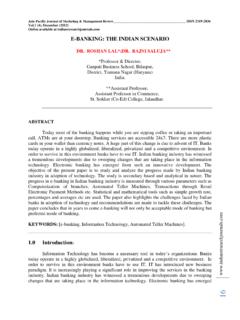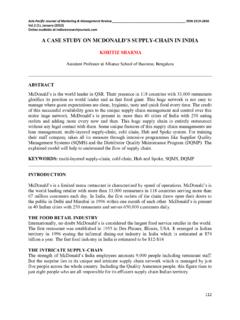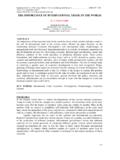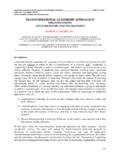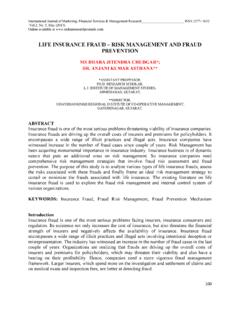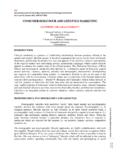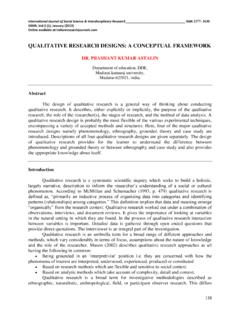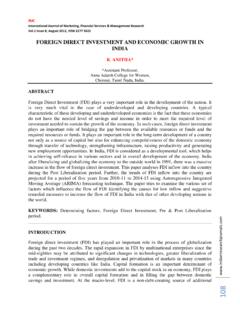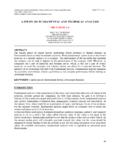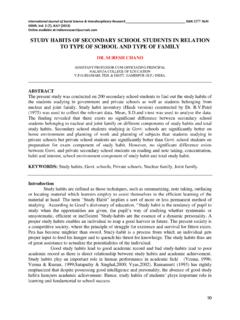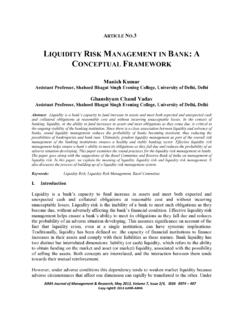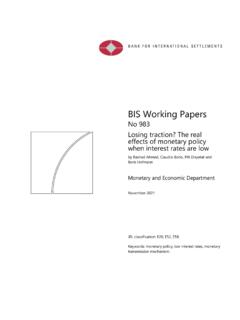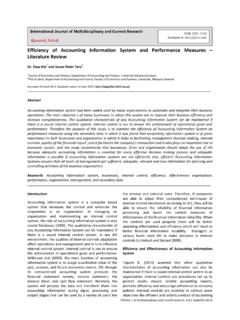Transcription of A STUDY ON THE PERFORMANCE OF INSURANCE …
1 International Journal of Marketing, Financial Services & Management Research_____ ISSN 2277- 3622 , No. 7, July (2013) Online available at 138 A STUDY ON THE PERFORMANCE OF INSURANCE COMPANIES IN ETHIOPIA DR. YUVARAJ SAMBASIVAM*; MR. ABATE GASHAW AYELE** *ASSOCIATE PROFESSOR, DEPARTMENT OF MANAGEMENT COLLEGE OF BUSINESS AND ECONOMICS DEBRE MORKOS UNIVERSITY, DEBRE MORKOS, ETHIOPIA **LECTURER, DEPARTMENT OF ACCOUNTING COLLEGE OF BUSINESS AND ECONOMICS DEBRE MORKOS UNIVERSITY, DEBRE MORKOS, ETHIOPIA ABSTRACT profitability is one of the most important objectives of financial management because one goal of financial management is to maximize the owner` s wealth.
2 This paper examined the effects of firm specific factors (age of company, size of company, volume of capital, leverage ratio, liquidity ratio, growth and tangibility of assets) on profitability proxied by Return on Assets. profitability is dependent variable while age of company, size of company, volume of capital, leverage liquidity ratio, growth and tangibility of assets are independent variables. The sample in this STUDY includes nine of the listed INSURANCE companies for nine years (2003-2011). Secondary data obtained from the financial statements (Balance sheet and Profit/Loss account) of INSURANCE companies, financial publications of National Bank of Ethiopia are analyzed.
3 From the regression results; growth, leverage, volume of capital, size, and liquidity are identified as most important determinant factors of profitability hence growth, size, and volume of capita are positively related. In contrast, liquidity ratio and leverage ratio are negatively but significantly related with profitability . The age of companies and tangibility of assets are not significantly related with profitability . KEYWORDS: factors , Growth, INSURANCE Companies, profitability , Tangibility of Assets. _____ INTRODUCTION The role of financial institutions in the economy of a country in general and INSURANCE companies in particular and it means their efficient and effective financial system through savings mobilization, risk transfer and intermediation.
4 Therefore, financial institutions, channel funds and transfers risks from one economic unit to another economic units so as to facilitate trade and resources arrangement. Recent research, as surveyed by Naveed et al (2011), shows that the efficiency of financial intermediation and transfer of risk can affect economic growth while at the same time institutional insolvencies can result in systemic crises which have unfavorable consequences for the economy as a whole. Hence, the important role that financial institutions such as INSURANCE companies remain in financing and insuring economic activity and contribute to the stability of the financial system in particular and the stability of the economy of concerned country in general is part of immune and repair system of the economy.
5 Therefore it requires empirical investigation so as to sort out what are the important factors affecting profitability of INSURANCE companies and this will help concerned bodies to focus on the relevant factors . Hence the efficient PERFORMANCE of the institutions has become important and investigations by different researchers focus on what factors determine the PERFORMANCE especially the financial PERFORMANCE of the sector. International Journal of Marketing, Financial Services & Management Research_____ ISSN 2277- 3622 , No. 7, July (2013) Online available at 139 EVOLUTION OF INSURANCE COMPANIES IN ETHIOPIA The history of INSURANCE service is as far back as modern form of banking service in Ethiopia which was introduced in 1905.
6 At the time, an agreement was reached between Emperor Menelik II and a representative of the British owned National Bank of Egypt to open a new bank in Ethiopia. Similarly, modern INSURANCE service, which were introduced in Ethiopia by foreigners, mark out their origin as far back as 1905 when the bank of Abyssinia began to transact fire and marine INSURANCE as an agent of a foreign INSURANCE company. According to a survey made in 1954, there were nine INSURANCE companies that were providing INSURANCE service in the country. With the exception of Imperial INSURANCE Company that was established in 1951, all the remaining of the INSURANCE companies were either branches or agents of foreign companies.
7 In 1960, the number of INSURANCE companies increased considerably and reached 33. At that time INSURANCE business like any business undertaking was classified as trade and was administered by the provisions of the commercial code. According to Hailu Zeleke (2007), the first significant event that the Ethiopian INSURANCE market observation was the issuance of proclamation No. 281/1970 and this proclamation was issued to provide for the control & regulation of INSURANCE business in Ethiopia. Consequently, it created an INSURANCE council and an INSURANCE controller's office, its strange impact in the sector.
8 The controller of INSURANCE licensed 15 domestic INSURANCE companies, 36 agents, 7 brokers, 3 actuaries & 11 assessors in accordance with the provisions of the proclamation immediately in the year after the issuance of the law. Accordingly as stated by the office mentioned above, the law required an insurer to be a domestic company whose share capital (fully subscribed) not to be less than Ethiopian Birr 400,000 for a general INSURANCE business, Birr 600,000 in the case of long-term INSURANCE business and Birr 1,000,000 to do both long-term & general INSURANCE business. The proclamation defined 'domestic company' as a share company having its head office in Ethiopia and in the case of a company transacting a general INSURANCE business at least 51% and in the case of a company transacting life INSURANCE business, at least 30% of the paid-up capital must be held by Ethiopian nationals or national companies.
9 After four years that is after the enactment of the proclamation, the military government that came to power in 1974 put an end to all private enterprises. Then all INSURANCE companies operating were nationalized and from January 1, 1975 onwards the government took over the ownership and control of these companies & merged them into a single unit called Ethiopian INSURANCE Corporation. In the years following nationalization, Ethiopian INSURANCE Corporation became the sole operator. After the change in the political environment in 1991, the proclamation for the licensing and supervision of INSURANCE business heralded the beginning of a new era.
10 Immediately after the enactment of the proclamation in the 1994, private INSURANCE companies began to increase. REVIEW OF LITERATURE Renbao Chen (2004) stated in their investigation that higher profits provide both the means (greater availability of finance from retained profits or from the capital market) and the incentive (a high rate of return) for new investment . Therefore, we can understand from the above explanation that INSURANCE companies have double responsibility: in one way they are required to be profitable so as to have high rate of return for new investment. On the other International Journal of Marketing, Financial Services & Management Research_____ ISSN 2277- 3622 , No.
